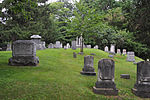Union Presbyterian Church (Scottsville, New York)
Churches in Monroe County, New YorkChurches on the National Register of Historic Places in New York (state)Monroe County, New York Registered Historic Place stubsNational Register of Historic Places in Monroe County, New YorkNew York (state) church stubs ... and 1 more
Presbyterian churches in New York (state)

Union Presbyterian Church, also known as First Presbyterian Church of Wheatland, is a historic Presbyterian church located at Scottsville in Monroe County, New York. It is a mid-19th-century vernacular Romanesque Revival–style building. It is composed of a three- by five-bay frame church with a 1+1⁄2-story rear wing that houses classrooms, offices, and kitchen facilities.It was listed on the National Register of Historic Places in 2004.
Excerpt from the Wikipedia article Union Presbyterian Church (Scottsville, New York) (License: CC BY-SA 3.0, Authors, Images).Union Presbyterian Church (Scottsville, New York)
Race Street, Town of Wheatland
Geographical coordinates (GPS) Address Nearby Places Show on map
Geographical coordinates (GPS)
| Latitude | Longitude |
|---|---|
| N 43.021666666667 ° | E -77.751944444444 ° |
Address
Race Street
14546 Town of Wheatland
New York, United States
Open on Google Maps










